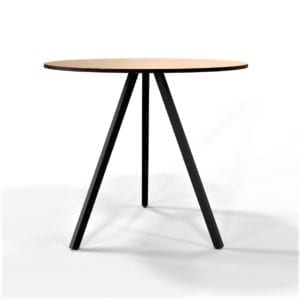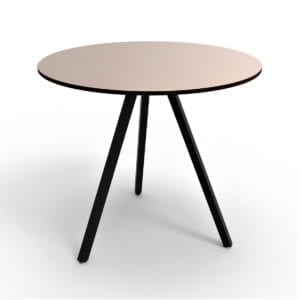Do 3 legs make more stable cafe tables than 4 legged tables?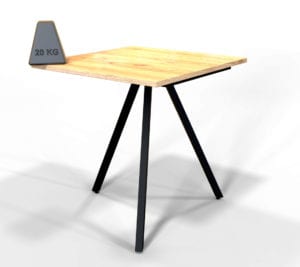
When we first developed our self-stabilising cafe tables, we used a 4-legged table base design. Many asked us “Why make a 4-legged base? Three legs are always more stable.”
This assumption is correct, as a tripod is always stable on uneven ground.
However, there are a few drawbacks in having 3-legged table designs. Tripods have a toppling stability problem and not a wobbly table problem. That is they do not rock but want to fall over if one places too much weight onto one corner of the table.
Let’s start by discussing “the stability triangle”.
The Stability Triangle.
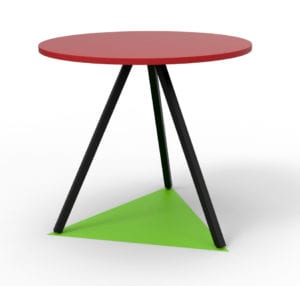
The 3-legged table base shown is fitted under a 700mm round cafe table top. If you connect up the three feet of the table base, it will form a triangle. This is known as the stability triangle and shown in green.
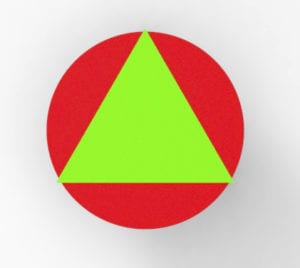 If you placed a weight on the table top within the green triangle, the table will always be stable.
Place a weight outside the green triangle, in the red areas, the table would become unstable. If the destabilising weight was great enough, the table could topple.
To reduce the risk of toppling, the stability triangle has to be as large as possible. This is not always practical solution as the legs of the base could stick out past the table top. In order to have safe 3-legged tables, there are a few guidelines that have to followed.
If you placed a weight on the table top within the green triangle, the table will always be stable.
Place a weight outside the green triangle, in the red areas, the table would become unstable. If the destabilising weight was great enough, the table could topple.
To reduce the risk of toppling, the stability triangle has to be as large as possible. This is not always practical solution as the legs of the base could stick out past the table top. In order to have safe 3-legged tables, there are a few guidelines that have to followed. International Safety Guidelines to Stable Cafe Tables.
There are safety standards or guidelines that specify the toppling stability criteria of a restaurant or cafe table. The guide stipulates that a table must not topple over if a 20kg test weight is placed 50mm from the table top edge.
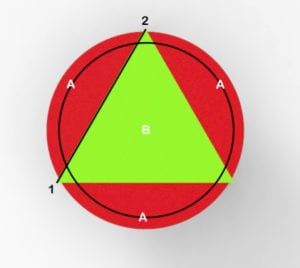
In the diagram above, the black circle indicates the 50mm mark from the edge of the table top where you would place the test weight.
The points “A” would be the most destabilising points if the 20kg weight was placed here. The point “B” indicates the centre of the table mass, which is the centre of a round cafe table if the legs of the base are symmetrical around the centre point of the table top. The weight of the table acts through this point and is known as the centre of gravity.
The Seesaw.
Designing a stable cafe table is like balancing a seesaw over it’s pivot point. The pivot point of the table “seesaw” is indicated by line 1-2. The test weight at point A has to be counterbalanced by the table weight acting through point B. The further point “A” is away from the green area, the heavier the table must be to stay within safety limits.
For example, if on a 700mm round table top the feet of the 3-legged base are lined up with the edge of the table top, the table must not weigh less than 10kg to comply with 20kg test weight specification.
If the same base as in the above example had a 900mm diameter top, then the weight of the table would need to be 20kg.
The larger the top relative to the base size, the heavier the table has to be. This is a simple enough principle to understand.
Incidentally this same principle also applies to tables with 4 legs.
The problem of stability arrises when you try and place a tripod base under a square or rectangular table top.
The Square Cafe Table top on 3 legs.
Square table tops can be placed onto 3-legged table bases. Although the same principle of “balancing” the table with a 20kg test weight is the same as with round tables, the calculation becomes a more complex.
Take a look at the green triangle with a 700mm square table top.
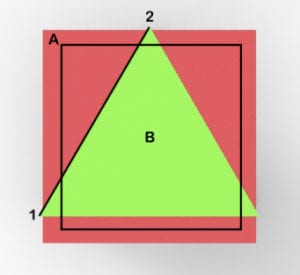
As you can see, the point A actually moves away from the triangle, which means the table has to be much heavier to counter balance the test weight. In our 700mm square restaurant table example above, the weight of the table would need to be in excess of 30kg. That is not practical as you would need two persons to move the table.
How to stabilise square Cafe tables with 3 legs.
To keep the explanations simple, to stabilise a square cafe table with 3 legs against toppling over, the red areas around the green triangle have to be reduced. This can be achieved by either
- Increasing the size of the green triangle, which is not practical as the legs can stick past the table top, or
- by moving the green safety zone triangle to position that reduces the red areas.
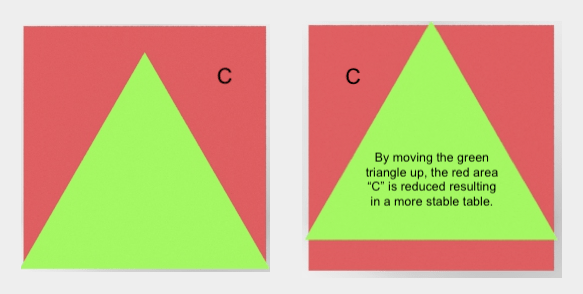
By doing this it is possible to find a position for the 3-legged base under the 700mm square top where combined weight of the table is about 21kg. This is a more manageable weight for a stable cafe table.
Use Counter weights to stabilise 3-legged cafe table?
It is possible to reduce the weight of 3-legged square cafe tables even more. This becomes even more complex calculation, as one has to add a counterweight in a strategic position under the table top. The table counterweight is similar to counterweights on a tower crane.

Below is an example of the counterweight positioned under the a table top.
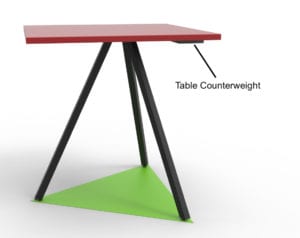
If its so “complex” is it worthwhile to have 3 legged Cafe tables?
There are many advantages for having three legged cafe tables. The advantages out-weight the disadvantages.
No Rocking.
As previously mentioned, 3 legged cafe tables are always stable, meaning the table will not rock. A seemingly very simple solution for stable tables, but a little complex in getting a safe workable solution. At Gyor we will provide you with ready made cafe and restaurant tables that are always stable.
A Weight Advantage.
Three-legged tables have to be heavier than four-legged tables, however there is an advantage to having weight. 4-legged tables can be lighter, however lighter tables tend to be “flimsy”. If one accidentally bumps a light weight table, the drinks on the table tend to spill. Normally the heavier the table, the more solid the table feels. If heavier tables are better, then why not use heavier 3 legged tables. Should there be a requirement to move tables in and out on a daily basis, it would be better to have lighter tables fitted with the Swoose table base to maintain stability.
No Moving Parts.
There many self-stabilising 4-legged tables on the market, some better than others. One thing they all have in common is that they all have moving parts. With 3 legged tables there are no moving parts, so nothing can go wrong.
Bases And Tops need to be Matched Correctly.
As there is no “3-legged” table base that fits all table tops, the table base manufacturer or supplier has to manufacture a base for each table top size or shape. So many table wholesalers do not supply 3 legged tables.
Not a problem for Gyro.
The Kitty tables range we developed addresses this problem. We design each of the bases to suit the table top that you require. We design our tables to ensure that the stable cafe table we supply, is 100% safety compliant.

